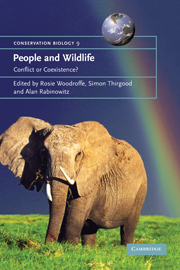Book contents
- Frontmatter
- Contents
- List of contributors
- Foreword
- Acknowledgements
- 1 The impact of human–wildlife conflict on natural systems
- 2 The impact of human–wildlife conflict on human lives and livelihoods
- 3 Characterization and prevention of attacks on humans
- 4 Non-lethal techniques for reducing depredation
- 5 Techniques to reduce crop loss: human and technical dimensions in Africa
- 6 Evaluating lethal control in the management of human–wildlife conflict
- 7 Bearing the costs of human–wildlife conflict: the challenges of compensation schemes
- 8 Increasing the value of wildlife through non-consumptive use? Deconstructing the myths of ecotourism and community-based tourism in the tropics
- 9 Does extractive use provide opportunities to offset conflicts between people and wildlife?
- 10 Zoning as a means of mitigating conflicts with large carnivores: principles and reality
- 11 From conflict to coexistence: a case study of geese and agriculture in Scotland
- 12 Hen harriers and red grouse: the ecology of a conflict
- 13 Understanding and resolving the black-tailed prairie dog conservation challenge
- 14 People and elephants in the Shimba Hills, Kenya
- 15 Safari hunting and conservation on communal land in southern Africa
- 16 Socio-ecological factors shaping local support for wildlife: crop-raiding by elephants and other wildlife in Africa
- 17 Jaguars and livestock: living with the world's third largest cat
- 18 People and predators in Laikipia District, Kenya
- 19 Searching for the coexistence recipe: a case study of conflicts between people and tigers in the Russian Far East
- 20 A tale of two countries: large carnivore depredation and compensation schemes in Sweden and Norway
- 21 Managing wolf–human conflict in the northwestern United States
- 22 Policies for reducing human–wildlife conflict: a Kenya case study
- 23 An ecology-based policy framework for human–tiger coexistence in India
- 24 The future of coexistence: resolving human–wildlife conflicts in a changing world
- References
- Index
20 - A tale of two countries: large carnivore depredation and compensation schemes in Sweden and Norway
Published online by Cambridge University Press: 23 November 2009
- Frontmatter
- Contents
- List of contributors
- Foreword
- Acknowledgements
- 1 The impact of human–wildlife conflict on natural systems
- 2 The impact of human–wildlife conflict on human lives and livelihoods
- 3 Characterization and prevention of attacks on humans
- 4 Non-lethal techniques for reducing depredation
- 5 Techniques to reduce crop loss: human and technical dimensions in Africa
- 6 Evaluating lethal control in the management of human–wildlife conflict
- 7 Bearing the costs of human–wildlife conflict: the challenges of compensation schemes
- 8 Increasing the value of wildlife through non-consumptive use? Deconstructing the myths of ecotourism and community-based tourism in the tropics
- 9 Does extractive use provide opportunities to offset conflicts between people and wildlife?
- 10 Zoning as a means of mitigating conflicts with large carnivores: principles and reality
- 11 From conflict to coexistence: a case study of geese and agriculture in Scotland
- 12 Hen harriers and red grouse: the ecology of a conflict
- 13 Understanding and resolving the black-tailed prairie dog conservation challenge
- 14 People and elephants in the Shimba Hills, Kenya
- 15 Safari hunting and conservation on communal land in southern Africa
- 16 Socio-ecological factors shaping local support for wildlife: crop-raiding by elephants and other wildlife in Africa
- 17 Jaguars and livestock: living with the world's third largest cat
- 18 People and predators in Laikipia District, Kenya
- 19 Searching for the coexistence recipe: a case study of conflicts between people and tigers in the Russian Far East
- 20 A tale of two countries: large carnivore depredation and compensation schemes in Sweden and Norway
- 21 Managing wolf–human conflict in the northwestern United States
- 22 Policies for reducing human–wildlife conflict: a Kenya case study
- 23 An ecology-based policy framework for human–tiger coexistence in India
- 24 The future of coexistence: resolving human–wildlife conflicts in a changing world
- References
- Index
Summary
INTRODUCTION
Norway and Sweden share the Scandinavian Peninsula and the people have similar languages, customs and lifestyles. Nevertheless, the situation regarding large carnivores, their depredations and the schemes devised to deal with these problems differ greatly. We view these two countries almost as ‘replicates’ to give us insight into how different types of livestock husbandry affect depredation levels and to compare compensation schemes. We will concentrate on sheep (Ovis aries) and semi-domestic reindeer (Rangifer tarandus) and will not consider predation on wild large game.
THE SPECIES OF LARGE CARNIVORES
Sweden and Norway have four species of large carnivores: the grey wolf (Canis lupus), wolverine (Gulo gulo), brown bear (Ursus arctos) and Eurasian lynx (Lynx lynx). All have been subject to lethal control since the seventeenth and eighteenth centuries with high state-financed bounties. The official policy was extermination, and this occurred over large areas. After official policies changed, the bounties were removed, and populations of all four species increased in size and distribution. Present policies include maintaining or promoting viable populations, balanced with mitigating losses they cause to farm livestock (primarily sheep), semi-domestic reindeer, hunting dogs, and large game animals (primarily moose (Alces alces) and roe deer (Capreolus capreolus)).
The wolf originally occurred over all of Scandinavia. During the early nineteenth century about 500 were killed annually, but it was exterminated from Scandinavia in the late 1960s. In 1982 a few wolves were observed in south-central Sweden/Norway. They reproduced in 1983.
- Type
- Chapter
- Information
- People and Wildlife, Conflict or Co-existence? , pp. 323 - 339Publisher: Cambridge University PressPrint publication year: 2005
- 52
- Cited by



